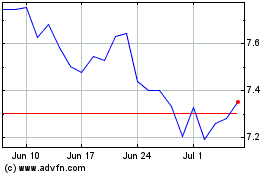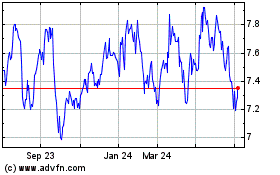2nd UPDATE: Italy Gas Market Still Dominated By Eni -Regulator
July 14 2009 - 9:01AM
Dow Jones News
Italy's natural gas market is still dominated by
state-controlled company Eni SpA (E), limiting competition and
keeping prices high, said the country's energy regulator
Tuesday.
The Italian gas market needs new liquefied natural gas receiving
terminals and pipelines to offer alternatives to Eni sources, said
the energy regulator, Autorita per l'Energia Elettrica e Gas, or
AEEG, in its annual presentation to parliament.
One problem "is the continuation, especially in the gas sector,
of vertical players that hold dominant positions in the market,"
Alessandro Ortis, head of AEEG, said in his speech to
parliament.
The regulator also urged lawmakers to introduce measures to
split Snam Rete Gas SpA (SRG.MI), Italy's biggest gas grid by
lines, from Eni.
The Italian government controls Eni with a roughly 30.3% stake,
while Eni holds just more than 50% of Snam Rete Gas' capital,
according to filings published on securities regulator Consob's Web
site.
"The government and parliament have already intervened on the
issue [of Snam Rete Gas] with a different opinion" to that of the
AEEG, said Eni Chairman Roberto Poli on the sidelines of the
event.
Gas is particularly important to Italy as a large percentage of
its electricity is generated from the fossil fuel. Italy doesn't
have nuclear power and it coal-fires a small amount of power
plants.
Ortis said 54% of Italian electricity is generated from gas. New
energy infrastructure is limited by too many obstacles, especially
an authorization procedure which is too slow and fraught with
uncertainties, he said in his speech.
Italy's wholesale energy prices are higher than the European
average, although the gap is closing, said Ortis. Gas prices are
about 15% higher if taxes are included, he added.
There are Italian buyers, independent from the main sector
players, willing to acquire strategic energy infrastructure assets,
which would ease concerns about large foreign companies snapping
them up and entering the key sector, Ortis said.
Italy's incentives to the renewables sector may need to be
assessed as the bill faced by energy consumers mounts, said Ortis.
AEEG estimates these incentives will cost EUR3.2 billion in 2010,
or twice the current amount, and climb to EUR7 billion in 2020.
"We have indicated the opportunity to verify the sustainability
over time and a review of the incentives mechanisms" of the
renewables sector, he said.
The regulator also said oil prices are "excessively volatile,"
also due to a "certain type" of speculator. To combat this
volatility, Ortis proposes setting up a European oil exchange and
rules that boost transparency.
Regulator Web site: http://www.autorita.energia.it
-By Liam Moloney, Dow Jones Newswires; +39 06 6976 6924;
liam.moloney@dowjones.com
(Guglielmo Valia, MF-Dow Jones, contributed to this
article.)
Terna Trasmissione Elett... (BIT:TRN)
Historical Stock Chart
From May 2024 to Jun 2024

Terna Trasmissione Elett... (BIT:TRN)
Historical Stock Chart
From Jun 2023 to Jun 2024
